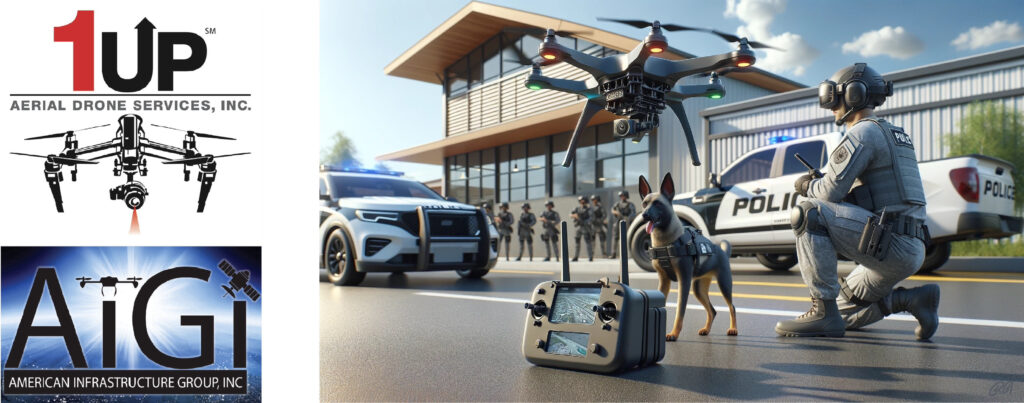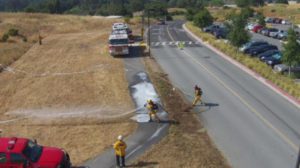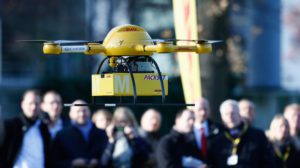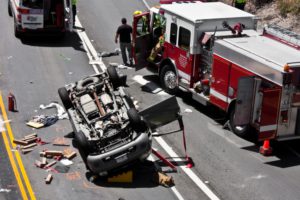Revolutionizing Public Safety With DFR:
How Drones as First Responders are Changing the Game
Written By Richard Armstrong – 1UP Drones Software Engineer – June 2024
Imagine a world where the first eyes on an emergency scene are not those of a human, but of a highly advanced drone, providing real-time aerial insights and critical data to first responders even before they arrive. This is not science fiction; it’s the reality of Drone as a First Responder (DFR) programs. By harnessing cutting-edge drone technology, DFR initiatives are transforming public safety, enabling faster, safer, and more effective emergency responses. In this article, we delve into the profound impact of DFR, exploring its applications, benefits, technological underpinnings, and the future of emergency response.

The concept of Drone as a First Responder (DFR) is quickly transforming the landscape of public safety by leveraging drone technology to enhance situational awareness, speed up response times, and improve overall safety for both first responders and the communities they serve. Let’s explore the meaning of DFR, detailed use cases, benefits, concerns, special technology involved, and how it integrates with current systems.
What is Drone as a First Responder (DFR)?
DFR programs deploy drones to emergency scenes, often arriving before human responders. These drones provide real-time aerial views and data, which help first responders assess situations more accurately and respond more effectively. DFR is particularly useful in scenarios where immediate information is crucial, such as active shooter situations, fires, search and rescue operations, and natural disasters.
Detailed Use Cases
Law Enforcement
In law enforcement, DFR drones can be dispatched to crime scenes to provide real-time video feeds, helping officers plan their approach and respond more safely. For instance, the Daytona Beach Police Department uses DFR drones for crowd surveillance during large events, search and rescue operations, and active shooter situations.
Saving Lives of K9 Officers with DFR FPV Drones
The use of First-Person View (FPV) drones in law enforcement can significantly reduce the risk to K9 officers during high-risk operations. Each year, many K9 officers lose their lives in the line of duty. In 2023, for example, 18 K9 officers died, with eight of these deaths resulting from gunfire and one from stabbing Deploying FPV drones such instead of K9 units to locate and help subdue suspects can greatly enhance the safety of these invaluable animal officers.
FPV drones such as the DJI Avata 2, being smaller, inexpensive, easy to fly, and more agile, can be sent into dangerous situations to gather real-time intelligence and locate suspects without the immediate risk of harm that a K9 might face. By using disposable FPV drones in these scenarios, law enforcement agencies can preserve the lives of K9 officers, allowing these dogs to continue their crucial roles in less dangerous capacities. The integration of this technology can potentially save many K9 lives annually, reducing the number of K9 fatalities caused by direct confrontations with armed suspects.
Firefighting
Fire departments use DFR drones to assess fire scenes before firefighters arrive, identifying hotspots and structural integrity issues. This information is critical in planning the safest and most effective response. The City of Clovis’ First Responder Drone Program has successfully used drones to manage fire emergencies, providing crucial insights into affected areas and aiding in resource allocation.
Medical Emergencies
Drones can also be used in medical emergencies to deliver essential supplies like defibrillators, blood, or medications to remote or hard-to-reach areas. They can provide a live feed to medical personnel, allowing them to assess the situation and give instructions to bystanders on the ground.
Ambulance Responses Delayed by Trains
One critical use case for DFR is in ambulance and fire responses that are delayed by trains at railway crossings. In many urban areas, trains can block intersections for extended periods, significantly delaying emergency response times. DFR drones can be deployed to provide an aerial view of the train’s position and identify the nearest unblocked crossing points. This real-time information allows dispatchers to guide ambulances and fire trucks to the optimal route around the train, reducing delays and potentially saving lives. Studies have shown that emergency response times can be reduced by up to 30% in areas with frequent train crossings using such drone-assisted navigation.
Benefits of DFR
Enhanced Situational Awareness
DFR drones provide a bird’s-eye view of incidents, allowing first responders to gather critical information before arriving on the scene. This can lead to better-informed decisions and more effective responses.
Faster Response Times
Drones can reach the scene of an incident faster than ground vehicles, providing real-time data that can be crucial in life-threatening situations. For example, drones deployed by Paladin Drones autonomously fly to 911 call locations, arriving within minutes to provide a live video feed to responders.
Resource Optimization
By providing immediate situational awareness, DFR drones help prioritize responses and allocate resources more effectively. This can be particularly beneficial in managing lower-priority calls without dispatching ground units, thereby freeing up resources for more critical incidents.
Increased Safety
DFR programs enhance the safety of both responders and the public by reducing the need for responders to enter potentially dangerous situations without adequate information. Drones can also help de-escalate situations by providing an eye in the sky that allows for more measured responses.
Concerns and Challenges
Privacy Issues
The use of drones raises concerns about privacy and surveillance. It’s essential to establish clear policies and regulations to ensure that drone operations respect individuals’ privacy rights and are used appropriately.
Technical Limitations
Drones have limited flight times and can be affected by weather conditions. Ensuring that drones are always ready for deployment and can operate in various conditions is crucial for the success of DFR programs.
Regulatory Hurdles
Obtaining necessary permissions and waivers, such as the FAA’s Beyond Visual Line of Sight (BVLOS) waiver, can be challenging and time-consuming. However, these waivers are essential for the full implementation of DFR programs.
Special Technology Involved
Drone Docks and Automated Systems
Automated drone docks allow for rapid deployment and charging, ensuring that drones are always ready for use. These docks can be strategically placed throughout a city to provide coverage for different areas.
DJI Dock 2
The DJI Dock 2 is a state-of-the-art docking station designed to support the automatic deployment and retrieval of drones. It ensures that drones are always charged and ready for rapid deployment. The DJI Dock 2 enhances the efficiency of DFR programs by providing a centralized location for drone operations, reducing response times significantly.
BVLOS and Autonomous Flights
BVLOS capability allows drones to operate beyond the visual line of sight of the operator, enabling wider coverage and more flexible operations. Fully autonomous drones can be dispatched automatically to 911 calls, providing immediate situational awareness without the need for a pilot on the scene.
Advanced Sensors and Communication Systems
DFR drones are equipped with high-resolution cameras, thermal imaging, spot lighting, speakers and communication systems that allow for real-time video streaming to multiple viewers. This technology ensures that responders have access to critical information as soon as it is available.
AVSS Parachute
The AVSS parachute system is available for various drone models, including those used in the DJI Dock 2. These parachute systems allow drones to fly over people without needing a special waiver. The AVSS parachute system is crucial for enhancing the safety and compliance of DFR operations in populated areas, ensuring that drones can safely operate in a wider range of environments. Recently, the FAA has approved a set of DJI drones equipped with the AVSS parachute for flying over people without a waiver, marking a significant advancement in DFR technology. These include the DJI M3D and M3TD, as well as the M300 and M350. The PRS-M350 is the ASTM F3322 compliant Parachute Recovery System for the DJI M350 RTK and is backwards compatible with PRS-M300. The PRS-M3DT is compatible with the DJI M3D and M3TD. Additionally, AVSS provides custom integration services for other commercial drones, including DroneUp’s Prism Sky platform and Blueflite’s Cobalt 46 platform, showcasing the versatility and adaptability of AVSS’s technology.
Integration with Current Systems
DFR drones integrate with existing emergency response systems, such as Computer-Aided Dispatch (CAD) systems, to provide seamless operations. For example, when a 911 call is received, the drone can be automatically dispatched to the caller’s location, providing a live feed to dispatchers and responders.
Integration with software platforms like Axon Air and Skydio Dock allows for centralized control and data management, enhancing the overall efficiency and effectiveness of emergency response operations.
Effectiveness and Situational Use
Most Helpful Situations
DFR drones are most effective in situations requiring immediate situational awareness, such as active shooter incidents, large public events, natural disasters, and search and rescue operations. They provide critical information quickly, allowing responders to act more decisively and safely.
Less Helpful Situations
DFR drones may be less effective in scenarios where weather conditions prevent safe flight or in highly congested urban areas where buildings and other obstacles can obstruct the drone’s view. Additionally, situations that require prolonged surveillance may challenge the drone’s battery life.
Conclusion
DFR programs represent a significant advancement in public safety, providing faster response times, enhanced situational awareness, and improved safety for both responders and the public. While there are challenges to overcome, such as privacy concerns and regulatory hurdles, the benefits of DFR are clear. As more agencies adopt this technology, we can expect to see continued improvements in emergency response and community safety.
For those interested in implementing a DFR program, it’s crucial to work with experienced providers and leverage the latest technology to ensure the program’s success. By integrating drones into their operations, public safety agencies can enhance their capabilities and better serve their communities.
If you are considering deploying a DFR program, 1UP Drones offers expert consultation and services and drone equipment to help you integrate drone technology into your operations. Contact 1UP Drones today to learn more about how we can help you revolutionize your agency’s rapid response capabilities and enhance public safety in your community. Together, let’s embrace and shape the future of law enforcement.
Visit our website at www.1updrones.com, email info@1updrones.com or give us a call at 972-808-5185. 1UP Drones – Elevating law enforcement and public safety, one flight at a time! 1UP Drones is a proud subsidiary of American Infrastructure Group, Inc. (AIGI).
References
- “Drone as a First Responder: A Complete Guide” – UAV Coach. https://www.uavcoach.com/drone-as-first-responder
- “Drone As A First Responder (DFR) Technology” – Paladin Drones. (https://paladindrones.io/dfr).
- “Starting a Drone as First Responder (DFR) Program” – Advexure. (https://advexure.com/blogs/news/starting-a-drone-as-first-responder-dfr-program).
- “Starting a Drone as a First Responder (DFR) Program” – Advexure (https://advexure.com/blogs/news/starting-a-drone-as-first-responder-dfr-program-a-comprehensive-guide)
- “Drone as First Responder (DFR) – Skydio Public Safety Solutions” – Skydio. (https://www.skydio.com/solutions/public-safety).
- “Introducing DJI Dock 2” – DJI. (https://www.dji.com/dock-2).
- “AVSS Parachute Recovery Systems” – AVSS. (https://www.avss.co/).
- “AVSS announces the PRS-M350: An ASTM F3322 compliant Parachute Recovery System for the DJI M350 RTK and Backwards Compatible with PRS-M300” – sUAS News – The Business of Drones (https://www.suasnews.com/2023/10/avss-announces-the-prs-m350-an-astm-f3322-compliant-parachute-recovery-system-for-the-dji-m350-rtk-and-backwards-compatible-with-prs-m300/).
- “AVSS Integrating Guided Parachute Recovery Systems For Drone Up and BlueFlite” – sUAS News – The Business of Drones (https://www.suasnews.com/2023/11/avss-integrating-guided-parachute-recovery-systems-for-drone-up-and-blueflite/)
- “AVSS announces new drone parachute for DJI Dock 2. The PRS-M3DT is compatible with the DJI M3D and M3TD.- AVSS (https://www.avss.co/2024/03/avss-announces-new-drone-parachute-for-dji-m3td-dock/)
- “Officer Down Memorial Page K9” – ODMP K9 (https://www.odmp.org/k9)
- “K9s WHO HAVE DIED IN THE LINE OF DUTY THIS YEAR” – PPAK9 – Project Paws Alive (https://www.ppak9.org/blog/k9s-who-have-died-in-the-line-of-duty-this-year/).
- “The path to implementing a Drone as First Responder (DFR) program” – Police1 (https://www.police1.com/police-products/police-drones/articles/the-path-to-implementing-a-drone-as-first-responder-dfr-program-6DMmW0U6ke5KnI3l/)
- “Drone Parachutes” – AVSS (https://www.avss.co/drone-parachutes/)
For further consultation and assistance with deploying DFR programs, contact 1UP Drones to explore how this technology can benefit your emergency response operations.


